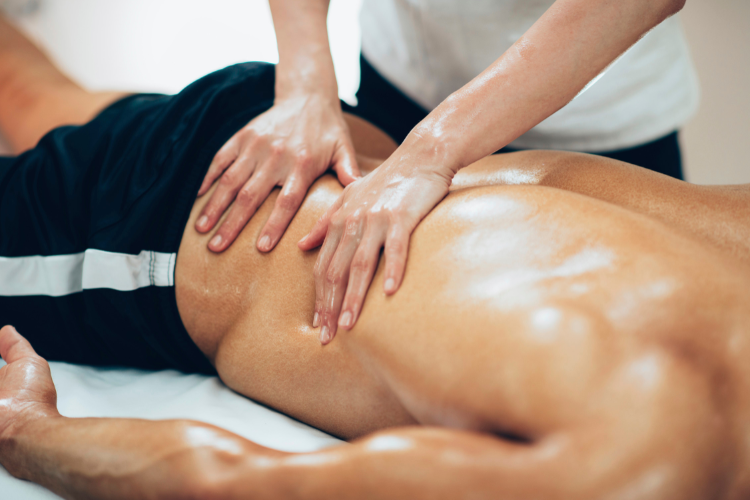Technology has certainly made our lives more convenient. However in this digital age, our bodies are now paying the price for our constant use of devices. We've become prisoners of our screens, spending endless hours sitting, hunching and scrolling causing poor postural habits and muscle dysfunction.
Ultimately, our increased use of technology has also increased instances of spinal problems. In fact, back and neck pain are now the #1 cause of job-related disability and one of the leading causes of missed work days. A lot of this chronic pain is due to our drastically changed lifestyles.
To put it simply, we aren’t built to be sedentary for nine hours a day at a desk.
In order to improve your spinal health, we’ll help you better understand the tumultuous relationship between technology, poor posture and pain. We’ll also uncover some tips you can implement today for a healthier spine.

The Correlation Between Back Pain and Desk Jobs
Is your desk job causing your back pain? According to a 2010 World Health Organization study, the average desk worker spends 82% of their day seated and 65% will go on to develop musculoskeletal issues, like back pain.
On top of this, the rise of remote and hybrid work culture has only made things worse. Recent surveys from Brandwatch show that, compared to pre-pandemic levels, far more people are reporting back pain and other joint issues.
One of the reasons we are experiencing record numbers of musculoskeletal pain is prolonged sitting.
Spending nine or more hours sitting, often slumped in a chair, weakens the postural muscles that support your neck and spine. When these muscles are weak, it’s a recipe for chronic back pain.

The Transition from Playgrounds to Pixels
While climbing trees and games of “tag” are fun parts of childhood, these activities are more important than we might think. Having an active childhood improves our core strength as adults and helps us build healthy habits later in life.
Unfortunately, many kids today are spending less time being active. There are rapid declines in childhood physical activity, especially over the last 30 years. This inactivity was accelerated during the COVID-19 pandemic when schools and sports clubs were closed. Instead of being outside developing muscular strength, essential for healthy posture, children (ages 8-10) now spend an average of 6 hours per day in front of a screen.
Technology has drastically shifted our lifestyles, as well as our children’s. At Park North Physical Therapy, we’ve witnessed firsthand how this increased screen time is affecting us. Younger patients and office workers are now coming in with growing complaints of back and neck pain.
4 Tips for a Healthier Spine and Better Posture
1. Develop Postural Awareness
Maintaining good posture throughout the day will better support your spine and help reduce your back pain. To achieve good posture, think about aligning your shoulders, hips and ears so that the curve of your neck sits on top of the curve of your lower back.
2. Get Up and MOVE
Regular movement is your ally when it comes to back pain. Incorporate movement breaks with exercises like air squats or lunges. Try taking short walks or stretching into your daily routine. Frequent movement will help counteract the damage caused by prolonged sitting. Try to move for five minutes at least once every hour.
3. Lighten Your Load
Carrying heavy bags around the New York City streets can take a toll on your spine. Reduce the weight of your bag or use a backpack for a more even weight distribution.
4. Upgrade Your Workspace
If you’re an office worker, your workstation may be sabotaging your posture. Simple ergonomic adjustments can make a world of difference in reducing strain on your neck and back.
Try these simple shifts to your office space:
- Elevate your monitor so that the address bar on your browser is at eye level.
- Adjust the seat height and back so your feet are flat on the ground and elbows rest easily on the desk with 90 degree bend.
- Elevate your chair, or try putting a small pillow under your bottom, so that your hips are slightly higher than your knees.
- Place your screen at roughly an arms length away from you.

Unlocking the Key to Better Posture Through Core Strength
A strong core is the secret weapon in your battle against poor posture and an aching spine. It's not just about having a toned midsection.
Core strength plays a crucial role in supporting your spine and maintaining proper alignment.
Your core includes the deep abdominals, back muscles and pelvic floor muscles. Together, these muscles act as a stabilizing force for your spine. They provide a solid foundation from which your body can move and maintain proper posture.
When your core is weak, it puts extra strain on your spine, leading to poor alignment and increased vulnerability to pain and injury. By improving your core strength, you can counteract the negative effects of prolonged sitting and technology-induced posture problems.
To develop a strong core and reap its benefits, incorporate specific exercises that target these muscles into your fitness routine. Planks, bridges, Russian twists and bird dogs are just a few examples of exercises that engage your core effectively.
Countering the Computer Slouch with Wall Angels
Rounding shoulders and upper back are common features of computer posture. To counteract the effects of your desk job, try out our favorite exercise, Wall Angels. This exercise targets your upper back, shoulders and core muscles to counteract the negative effects of prolonged sitting and promote a more upright posture.

Here's how to perform the Wall Angel exercise:
- Find a clear wall space: Stand with your back against a flat wall, ensuring your feet are about six inches away from the wall.
- Assume the starting position: Relax your shoulders and allow your back to rest against the wall. Your feet should be hip-width apart, and your heels, buttocks, and shoulder blades should be in contact with the wall. Engage your core by drawing your belly button in towards your spine. Tuck your chin in. Place your elbows against the wall at a 90-degree angle, with your upper arms parallel to the floor. This is your starting position.
- Slide your arms up: While maintaining contact with the wall, slowly slide your arms up towards the overhead position. Keep your elbows and wrists in contact with the wall as you raise your arms. Make sure not to arch your lower back or lift your heels off the ground.
- Hold and squeeze: Once your arms are fully extended overhead, pause for a moment and squeeze your shoulder blades together. Feel the stretch in your chest and the activation of your upper back muscles.
- Return to the starting position: Slowly lower your arms back down to the starting position, maintaining contact with the wall at all times. Keep your core engaged and your back against the wall throughout the movement.
Repeat this exercise for 10 to 15 repetitions, focusing on maintaining proper form and engaging the target muscles. As you become more comfortable with the Wall Angel exercise, you can gradually increase the number of repetitions or hold the overhead position for a few seconds longer.
For more exercise examples and postural education videos, visit our Instagram page or Youtube channel.
Pain-Free Living with Park North Physical Therapy
Don't let technology and a sedentary lifestyle affect your physical health. Contact us at Park North PT and schedule a spinal assessment with one of our skilled physical therapists at our Harlem or Morningside Heights locations in NYC.







